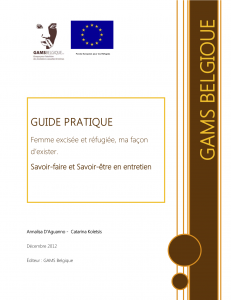
Description
Practical guide for FGM workers
Medium
- 56-page document
- Five clinical case vignettes
- Drawings of four points of quick relief
- Glossary
- Bibliography
- Suggested reading
- Appendix – The tale of two brains
Reference
D’Aguanno & Koletsis. Guide pratique – Femme excisée et réfugiée, ma façon d’exister – Savoir-faire et savoir-être en entretien. Ed. GAMS Belgique, Brussels, 2012.
Concept
The authors have been working as psychologists for several years, offering personal assistance and support to women victims of sexual mutilation and forced marriage.
They also give training sessions about the psychological aspects of helping women victims, which means they are often confronted with the questions, worries and feelings of distress that the trainees have experienced when dealing with victims.
In this manual, they try to answer these needs by providing tools/resources for coping with the feelings of distress experienced by women victims and with the personal anxiety they are facing as psychological/medical/social or even judicial workers.
Objectives
The objective is to provide ideas for understanding certain behaviours and psychological mechanisms, for encouraging professionals to pay attention to their own (emotional) situation when dealing with women victims, for thinking consciously, and for questioning their own professional practices, in order to develop the necessary psychological and practical knowhow for dealing with these women, adapted to the women’s situation and to their own.
How to use
Each clinical vignette can be read independently. You can browse through the document and use it as you see fit. The clinical vignette is captured in a text box and tries to answer the following questions:
- Why this reaction?
- What has the aid worker done?
- What works?
- What should be avoided?
Good to know
The guide is available in French and Dutch and may also be obtained from the documentation and publication center of the Fédération laïque des centres de planning familial (FLCPF), Rue de la Tulipe 35, 1050 Brussels.
The guide has been developed by a psychologist and a psychotherapist who have more than four years of experience working with women victims of violence (and of FGM in particular). The vignettes represent difficult situations exposed by professionals during training sessions held by GAMS Belgique. The guide has been proofread by actors in the field.
A joint publication on therapy for women who have undergone FGM will become available in 2014.
This guide was financed by the European Refugee Fund (ERF).
